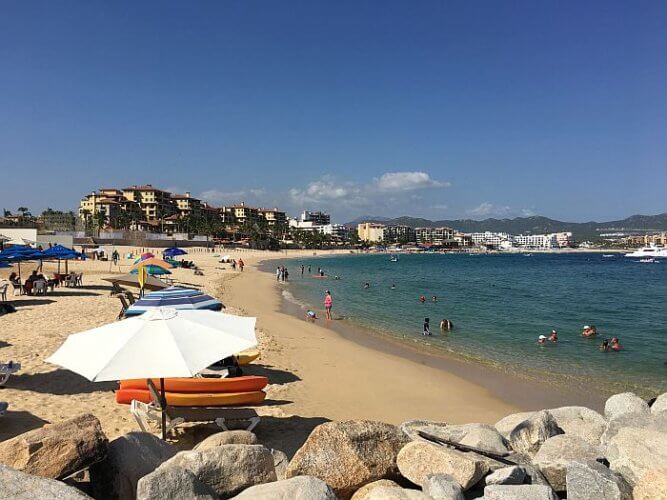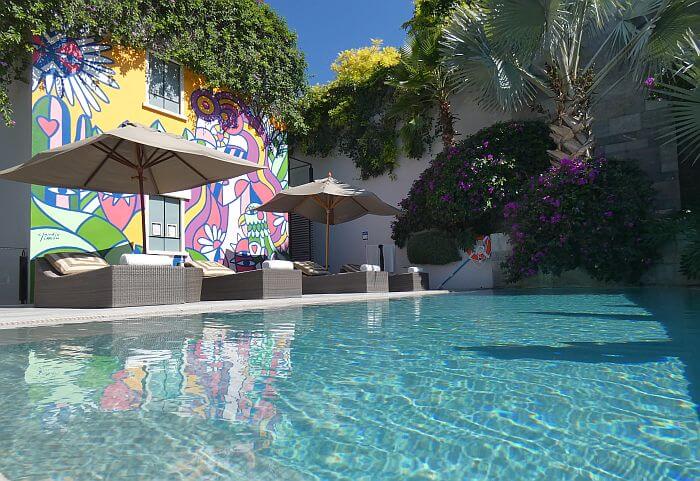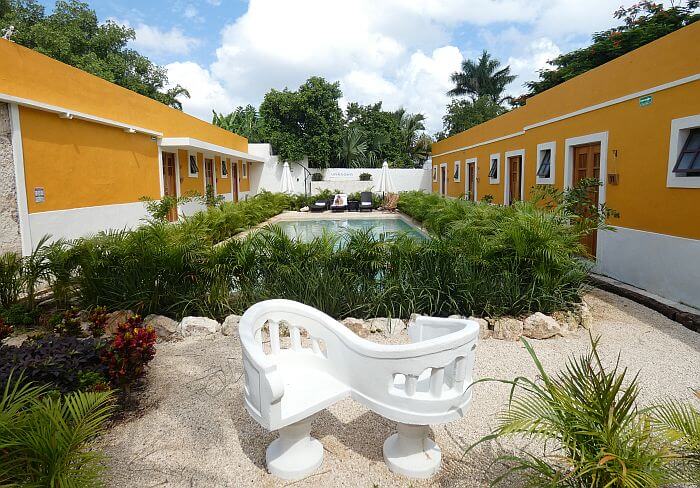We have plenty of reviews of hotels and resorts in Mexico on Hotel Scoop and for good reason. Mexico was already one of the 10 most popular tourist destinations before the pandemic hit and they’ve surely vaulted close to the top since then because they never closed their borders. Cancun airport had more foreign arrivals in 2021 than any other airport in the world except Dubai.
Mexico has been especially easy to visit for Americans since they can just arrive with a passport in hand, but there have been some changes, both official and unofficial, for visitors from many countries. So we thought it would be useful to highlight the current state of Mexican visa policy and what you need to know, with a bit of help from Natvisa.
First the big health question though: do you need to be vaccinated or tested for Covid-19? No and no. Mexico has been either health foolish or business savvy depending on where you stand. The unvaxxed are still welcome and while you’ll probably need to be tested to return to your own country, you don’t need a Covid test to travel to Mexico. You just fill out a health form attesting that you don’t have any symptoms (and your temperature may be checked at various points to confirm that you don’t have a fever.)
Visa Exemptions for Mexico
There’s a good chance that if you’re reading this from North America or Europe, you don’t need to obtain a visa for Mexico in advance. Those holding passports from the USA, Canada, UK, EU, or Japan do not need to obtain a Mexican visa in advance. This is also true for Alianza del Pacífico members such as Chile, Colombia, and Peru. You just enter with a valid passport and you’ll receive anywhere from two weeks to 180 days in your passport. More on that duration in a minute.
Also, citizens of all countries with valid multiple-entry American, Schengen, Canadian, Japanese or English visas (of all categories — tourist, business, transit, etc.) can enter Mexico without a visa if the purpose of the trip is tourism. So if your passport doesn’t give you visa-free entry, another visa you have might.

A valid visa must be open for at least six months and must be valid at the time of entry into Mexico. It is not necessary that it covers the entire trip. A preliminary visit to the country that issued it is not necessary for this visa. The duration of stay in Mexico should not exceed 180 days and you may only get 30 depending on your nationality.
Unlike a simplified electronic permit, a tourist visa is issued at the consulate and allows multiple entries within 180 days or ten years.
If you’re just passing through, most nationalities arriving at local airports are allowed visa-free transit within 24 hours, provided that the tourist arrives in Mexico by plane with a visa and tickets to the final destination. At the same time, it is not allowed to leave the controlled area of the airport. In some cases, it is necessary to apply for a tourist visa in advance.
Mexican Visas, SAE, and ETA
Citizens of some countries need to obtain an electronic permit to enter Mexico instead of a visa: Sistema de Autorización Electrónica (SAE). This type of document is not a visa, but it replaces a visa when crossing the border of Mexico by air.
Some visitors, such as travelers from Russia, Turkey, and Ukraine, need to obtain an Electronic Travel Authorization (ETA) for Mexico before they travel. They can apply for the ETA online, paying a fee at the same time, and will receive notice when it is approved. Only after formal approval can they then travel to Mexico.
There are currently more than 100 countries where citizens need some kind of permit in advance to visit Mexico. Some are obvious pariah states such as Afghanistan, Syria, Cuba, and Myanmar, but others include China, neighboring Guatemala, and Brazil. See the official government list here (in Spanish).
Check with your local Mexican consulate if your passport is on the list. In some cases, you may just need to apply online and there won’t be much hassle. In some cases, you just fill out a questionnaire with your vitals, hit “send,” and get an answer back automatically if you didn’t set off any red flags. You then get a document with a barcode to print out and bring.
In some cases, the validity period of the permit (entry) is only 30 days from the date of issue. After the expiration of the validity period, you can request a new permit. The period of stay in the country is determined by the terms specified when filling out the electronic questionnaire. This permit gives the right to enter Mexico once.
The FMM and Your Number of Days in Mexico
Every foreign citizen, including temporary and permanent residents of Mexico, upon arrival in the country at passport control, must submit a completed immigration form. It is also called a tourist visa or FMM (Forma Migratoria Multiple). Immigration will take the top part of this stamp both parts, and hand you back the bottom section, which you must hand over upon departure. Put this in a safe place with your passport!
It is important to know that it is in this document, and only in it, that it will indicate how many days you have the right to stay in Mexico as a tourist. You can’t lose your immigration form. If you lose it, you won’t be able to leave Mexico until you get a new FMM. Some websites advise you to fill out this form online in advance, but it’s not advised to do that now since it has security measures like most currencies do to show that it is official. So just assume you can get the FMM form on your flight to Mexico or just before the immigration counters at airports before passport control. All data must be entered by hand in Latin letters.
In the past, nearly everyone who entered Mexico from the USA, Canada, UK, or EU got 180 days on their FMM, with few questions asked. This was a dream for snowbirds who come down every year and also made Mexico one of the most popular destinations for digital nomads during the pandemic. Unfortunately, some people overstayed their visa, others kept going and coming for years on temporary “tourist” visas, and somebody in the government apparently got annoyed. Despite all the money these people brought in (with very little use of public services), the government got the word out to immigration officials in late 2021 to stop giving out so much time to everyone automatically, especially those who were coming in with no clue about where they’d be staying.
Now many tourists are only getting what they actually need, whether that’s 14 days or 60. Those who request 180 days may be asked for much more documentation than in the past, such as a long-term lease or owned real estate, a return ticket, and even proof of financial solvency. If intending to live in Mexico, even for just half the year, it’s now more important than ever to get a residency visa.

Non-Tourist Mexican Visa Options
Did you visit Mexico and love it so much that you wanted to stick around? You’re not alone. Most estimates put the number of foreigners living in Mexico at more than two million, more than half of those being Americans. While some are still taking their chances and arriving with tourist visas, most who are putting down roots have gotten temporary or permanent residency.
To become a resident of Mexico, it is nearly always necessary to apply first at a consulate in your home country. You must bring a pile of documents, the most important being the ones that prove financial solvency. In reality, you must prove a much higher income or savings amount than you actually need to live in Mexico, but most consulates use a formula that’s 300 times the Mexican minimum wage, so you need to be 300 times richer than a construction worker or dishwasher.
Consulates are far from consistent in how they apply the formula, the exchange rate, or your status—sometimes they’re more lenient with retirees than younger applicants. To be safe though, assume you’ll need to prove income of roughly $2,700 per month for the past six months to a year or have an ongoing savings balance of at least $46,000 to get temporary residency. The savings can be the total of what’s in multiple accounts, such as IRAs/401Ks. Again, your local consulate may demand less, but if you’re not there, find a way to shift some money around at least six months before you apply.
Some applicants are able to go straight to permanent residency by illustrating a much higher income and/or savings level. This is more common for retirees. Otherwise, you usually need to be a temporary resident for four years before you can jump up to permanent.
The most complex package of documents requires a work visa, which provides for a stay in Mexico during the contract concluded with the employer. This is tied to your employer, so you need a new one if you change jobs. At the time of writing, Mexico did not offer any kind of digital nomad visa like many other countries are starting to do.
A student visa makes it possible to legally stay in the country during the entire period of study. An extension of the visa may be considered for each specific case.
As with anything related to a visa more complicated than a tourist one, it’s best to do some solid research on the subject before making any moving plans and before making that consulate appointment. If you’re just heading down on a flight from Canada or the USA for a one-week vacation, however, you can forget all this and just look forward to your free-flowing margaritas!






